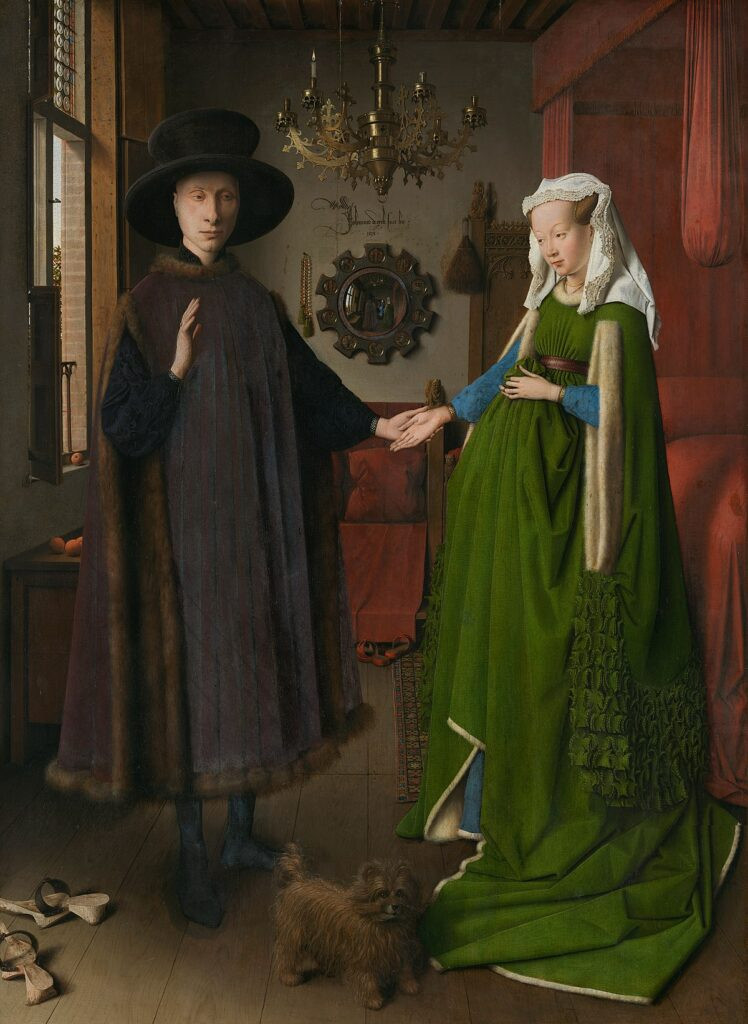Step into the captivating world of John Van Eyck, a pivotal figure of the Northern Renaissance, and prepare to be mesmerized by his iconic masterpiece, The Arnolfini Portrait. This painting is far more than just a visual delight; it’s a fascinating portal into the artistic innovation and cultural nuances of 15th-century Europe. Before we immerse ourselves in the intricate details of this celebrated artwork, let’s first explore the life and legacy of the artistic visionary behind it – John van Eyck.
Who was John Van Eyck?
 John Van Eyck Portrait
John Van Eyck Portrait
Imagine the vibrant artistic scene of the late 14th century, centered in Maaseik, present-day Belgium. Here, John van Eyck emerged, an artist whose meticulous approach and groundbreaking oil painting techniques would redefine the trajectory of art history. Van Eyck rose to prominence during the flourishing Northern Renaissance, a period marked by a renewed interest in classical art, humanism, and naturalism, particularly in Northern Europe. His enduring contribution? The refinement and popularization of oil glazing, a technique that bestowed upon his paintings an unparalleled luminosity and depth, setting a new benchmark for realism in art.
FUN FACT: While often credited with inventing oil painting, John van Eyck actually perfected existing oil-based techniques, elevating them to an unprecedented level of artistry and durability.
Explore a curated collection of artworks inspired by John van Eyck on Singulart
A Career Forged in Courtly Brilliance
John van Eyck’s career trajectory ascended dramatically when he secured the prestigious position of court painter to Philip the Good, the Duke of Burgundy. This appointment was a turning point, not only ensuring financial stability but also placing him at the heart of a culturally rich environment, exposed to diverse artistic currents and influential patrons. His artistic philosophy was deeply rooted in the meticulous observation of nature, evident in his paintings characterized by astonishing detail, masterful manipulation of light and shadow, and a profound sense of realism that captivated his contemporaries and continues to inspire artists today.
Decoding The Arnolfini Portrait: A Window to 1434
 The Arnolfini Portrait by John van Eyck
The Arnolfini Portrait by John van Eyck
| Aspect | Details of The Arnolfini Portrait |
|---|---|
| Creator | John van Eyck |
| Creation Year | 1434 |
| Artistic Medium | Oil paint on oak wood panel |
| Artistic Classification | Portraiture |
| Art Period | Northern Renaissance |
| Dimensions | 82.2 cm × 60 cm (approximately 32.4 in × 23.6 in) |
| Unique Versions | Single Original |
| Current Location | National Gallery, London, United Kingdom |
Let’s now turn our attention to the centerpiece of our exploration – The Arnolfini Portrait. Transport yourself to 1434, and envision stepping into a room where Giovanni Arnolfini, a prosperous merchant from Lucca, and his wife are captured in an intimate and enigmatic scene. John van Eyck’s masterful brushwork renders every detail with such precision that you can almost discern the textures of their luxurious clothing and perceive the atmosphere of the room. It’s akin to encountering a 15th-century snapshot, a moment suspended in time and imbued with layers of meaning.
Analyzing the Scene: Characters and Setting
Giovanni Arnolfini and his wife command the central space in the foreground of the composition. Giovanni, distinguished by his opulent fur-trimmed robe, extends his hand in a gesture that is widely interpreted as a marriage vow or a formal pledge. His wife, elegantly attired in a rich green gown and an elaborate headdress, stands beside him, her gaze directed towards her husband, creating a sense of connection and solemnity.
The room itself is a meticulously rendered space, brimming with symbolic objects and details that invite close scrutiny. The brass chandelier, the geometrically patterned carpet, and the intricate candelabra hanging from the ceiling are all depicted with astonishing accuracy. Van Eyck invites the viewer to become an active participant, encouraging a detailed examination of every element, promising deeper insights into the painting’s narrative and symbolism.
The All-Seeing Convex Mirror: A Masterstroke of Perspective
Our gaze is then drawn to the convex mirror positioned at the back of the room, a remarkable element that showcases Van Eyck’s artistic ingenuity. This mirror is not merely a decorative feature; it serves as a sophisticated narrative device, expanding the visual space and adding layers of complexity to the scene. It reflects the backs of the Arnolfini couple, but, more intriguingly, it reveals two additional figures standing in the doorway. Their presence is shrouded in mystery, sparking debate among art historians: are they witnesses to the marriage ceremony? Is one of them John van Eyck himself, acting as a signatory to the event? The mirror’s slightly distorted reflection introduces an element of enigma, encouraging multiple interpretations and enriching the painting’s narrative depth.
Symbolism Woven into Every Detail
The enduring fascination of The Arnolfini Portrait stems not only from its technical brilliance but also from its rich tapestry of symbolism. John van Eyck, functioning as a visual storyteller, imbued almost every element within the painting with symbolic meaning. The small dog at the couple’s feet traditionally represents fidelity and loyalty, acting as a silent witness to their union. The oranges placed on the windowsill, a rare and costly commodity in 15th-century Bruges, symbolize wealth, prosperity, and possibly fertility. The discarded clogs suggest a sacred space, and the single lit candle in the chandelier may represent the presence of God or the all-seeing eye. This intricate visual language transcends the literal depiction of a wedding scene, inviting viewers to actively decode the hidden messages and understand the deeper meanings embedded within the canvas.
“John Van Eyck Was Here”: The Artist’s Personal Stamp
Adding a unique and personal touch, John van Eyck includes his signature above the mirror: “Johannes de eyck fuit hic. 1434” – “John van Eyck was here. 1434.” This inscription is more than just a signature; it’s a playful and assertive declaration of his presence as a witness and creator within the scene. It breaks the conventional boundaries between the artwork and the viewer, creating a direct connection to the artist across centuries. In its boldness and directness, this signature feels remarkably modern, highlighting Van Eyck’s innovative and self-aware approach to his art.
The Arnolfini Portrait at the National Gallery: A Timeless Masterpiece
Today, The Arnolfini Portrait is prominently displayed at the National Gallery in London, drawing crowds of admirers from around the globe. The painting’s journey from John van Eyck’s workshop in Bruges to its esteemed position in London is a testament to its enduring artistic significance and historical value. Each visitor who stands before this masterpiece becomes a participant in a journey through time, encountering a moment frozen in time by oil paint and masterful artistry.
Intriguing Facts About The Arnolfini Portrait
The Mirror’s Secret: Take a closer look at that convex mirror – it’s not just reflecting the room. It cleverly captures the Arnolfini couple and, more surprisingly, two additional figures standing in the doorway. Art historians speculate these could be witnesses to the scene, or even a self-portrait of Van Eyck himself with an assistant. This mirror technique was incredibly innovative for its time, demonstrating Van Eyck’s mastery of perspective and composition.
A Symphony of Symbols: The Arnolfini Portrait is like a visual puzzle box filled with symbolism. Every object is laden with potential meaning. The dog represents fidelity, the oranges suggest wealth, and even the color green of the wife’s dress might symbolize fertility. Van Eyck meticulously layered meaning into every corner of the painting, creating a rich and complex visual experience.
The Artist’s Bold Signature: Even John van Eyck’s signature is noteworthy. His inscription “John van Eyck was here, 1434” above the mirror is an unprecedentedly direct and personal statement for the period, adding a touch of the artist’s personality and presence directly into the artwork.
Frequently Asked Questions
What is the generally accepted interpretation of The Arnolfini Portrait?
Art historical interpretations, such as those proposed by Margaret D. Carroll, suggest the artwork commemorates a marriage ceremony, possibly functioning as a legal record of the union. Carroll further proposes that the painting served to affirm Giovanni Arnolfini’s social standing as a reputable merchant and potential official within the Burgundian court.
What mysteries and debates surround The Arnolfini Portrait?
While it is widely believed that the subjects are Giovanni di Nicolao Arnolfini and his wife, Costanza Trenta, historical records indicate Trenta’s death in 1433 from childbirth. This discrepancy, given the 1434 date inscribed on the painting, has fueled numerous theories regarding the woman’s true identity and the painting’s precise purpose. Some theories suggest it might be a memorial portrait or depict Arnolfini with a different wife or betrothed.
Conclusion: The Enduring Legacy of John Van Eyck’s Masterpiece
In conclusion, The Arnolfini Portrait transcends the definition of a mere painting; it stands as a vibrant testament to John van Eyck’s unparalleled artistic brilliance and innovative spirit. It invites us to appreciate not only the breathtaking technical skill evident in each brushstroke but also the profound layers of meaning embedded within its meticulously crafted composition. Preserved within the National Gallery, this iconic masterpiece continues to captivate, challenge, and inspire viewers, demonstrating the timeless power of great art to resonate across centuries and speak to the depths of the human experience. The next time you encounter this remarkable canvas, allow yourself to be drawn into its intricate details, unravel its enigmatic narrative, and experience the enduring magic of The Arnolfini Portrait and the genius of John van Eyck.

